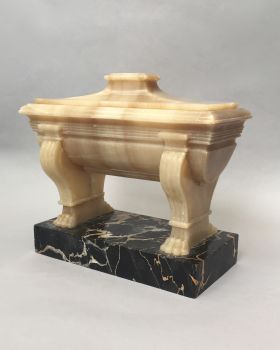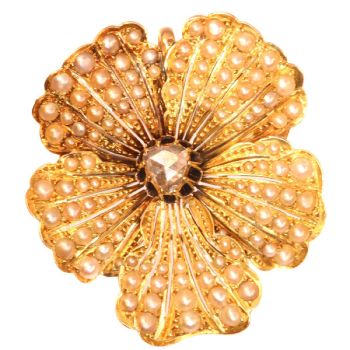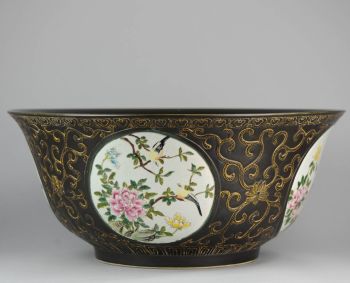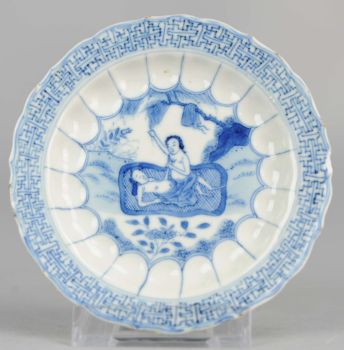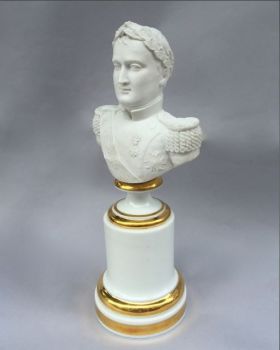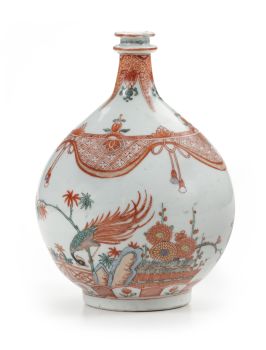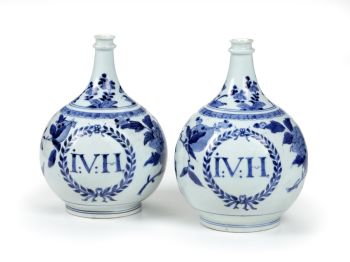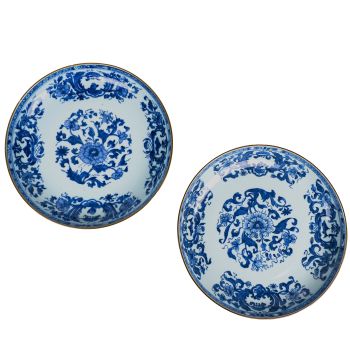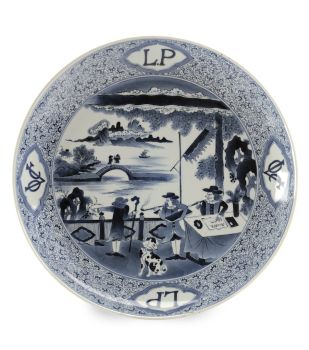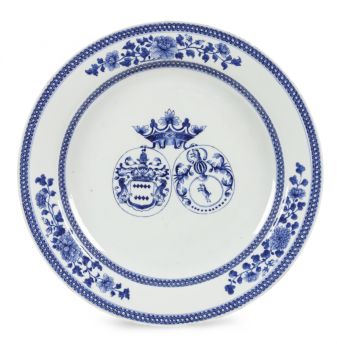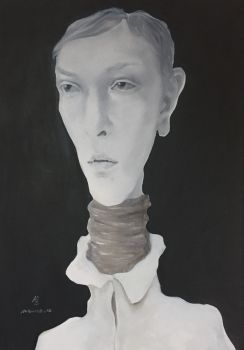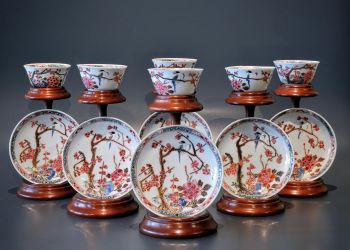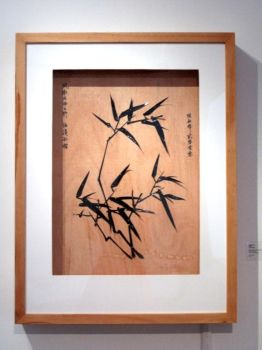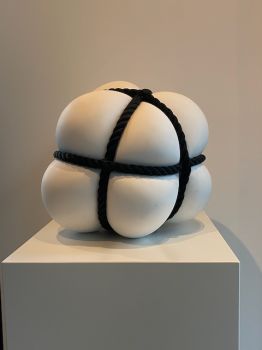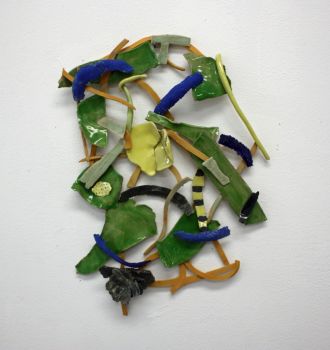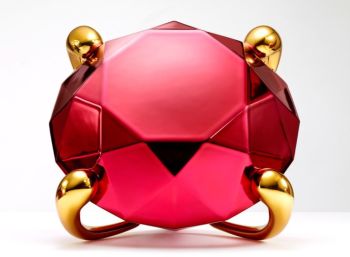A Chinese porcelain blue and white 'Mantou Xin' bowl, Kangxi period (1661-1722) 1700 - 1720
Onbekende Kunstenaar
Porselein
7.10 cm, ø 19.20 cm
ConditionGood
Prijs op aanvraag
Menken Works of Art
- Over kunstwerkA blue and white bowl with various Taoist symbolic decorations.
Kangxi period (1661-1722), ca. 1700-1720, China.
The low bowl with interesting convex centre and flared wall.
Inside showing four figures representing Lan Caihe holding a ruyi and a flower basket, slung on a hoe (ancient farming tool) over the shoulder. The convex centre surrounded by a band showing the Eight Treasures (pearl, rhinoceros horn, shell, fishes, never-ending knot, books and a coral stick).
The outside with a band of Wan or Swastika’s in relief with the recess background cleverly showing the biscuit of the porcelain. Underneath the upper swastika band showing the Flowers of the Four Seasons. Underneath the flowers a band of ruyi heads, the bowl resting on a high footring with concave centre.
About Lan Caihe:
Lan Caihe is one of the eight Taoist immortals and the patron saint of florists and gardeners. Sometimes portrayed as a woman, other times as a hermaphrodite, Caihe is a symbol of elusive pleasure and represents innocence and happiness. It is said Lan Caihe wandered the streets as a beggar in worn clothing and with one foot bare, denouncing the elusive pleasures of this fleeting life.
About the Eight Treasures:
Also known as ba bao, this early motif of eight symbols was not merely a decorative pattern that occurred on Chinese works of art, but originally had a symbolic importance reflecting aspirations for status, wealth, and position as well as philosophic allegiance.
About the Flowers of the Four Seasons:
This representation is frequently seen in paintings or depictions on porcelain. A flower or plant representing each of the seasons: plum blossom for winter, grass orchid for spring, lotus for summer and chrysantemum for autumn.
About the Wan or Swastika symbol:
The Wan has been used as a design motif in every imaginable medium. In spite of contrasting views on its origin, it is historically tied to Buddhism and in Chinese folklore it symbolised good luck and eternal abundance. The term Swastika is derived from the Sanskrit su “well” and as “to be”, meaning “so be it” and denoting resignation of the spirit. It is styled the “ten thousand character sign” (wànzì) and is said to have come from heaven. It is described as “the accumulation of lucky signs possessing ten thousand efficacies”. It is also regarded as the symbol or seal of Buddha’s heart and is usually placed on the heart of Shâkyamuni Buddha.
Provenance:
From a private Dutch noble collection.
Identical bowls can be found in several museum collections:
Victoria & Albert Museum London (accession number C.941-1910)
The Frick Collection, New York (accession number 1965.8.75)
Rijksmuseum Amsterdam (object number AK-NM-6845)
Groninger Museum (object number 1899.0360)
Museum Arnhem (inv. nr. GM10.412).
Lit:
Hartog, Stephen - Pronken met Oosters Porselein, p. 67 / nr. 49.
Dimensions:
Diameter 19.2 cm, height 7.1 cm.
Condition (DM for more condition pictures):
Four chips on the mouth rim, furthermore in perfect condition.
Inv. No: A00389 - Over kunstenaar
Het kan voorkomen dat een kunstenaar of maker onbekend is.
Voor sommige werken is het niet te bepalen door wie het gemaakt is of dat het is gemaakt door (een groep) ambachtslieden. Voorbeelden zijn beelden uit de Oudheid, meubels, spiegels of handtekeningen die vaak niet duidelijk of leesbaar zijn. Maar ook sommige werken zijn helemaal niet gesigneerd.
Ook kunt u de volgende beschrijving vinden:
•"Toegeschreven aan …." waarschijnlijk een werk van de kunstenaar maar niet zeker of gedeeltelijk
•“Atelier van ….” of werkplaats van” een werk uitgevoerd in het atelier of atelier van de kunstenaar, eventueel onder zijn toezicht
•“Cirkel van ….” een werk uit de periode van de kunstenaar die zijn invloed laat zien, nauw verbonden met de kunstenaar maar niet noodzakelijkerwijs zijn leerling
•“Stijl van ….” of “Volger van ….” een werk uitgevoerd in de stijl van de kunstenaar, maar niet noodzakelijk door een leerling; kan eigentijds of bijna eigentijds zijn
•“Wijze van ….” een werk in de stijl van de kunstenaar maar van latere datum
•"Na …." een kopie (van welke datum dan ook) van een werk van de kunstenaar
•“Getekend…”, “Gedateerd….” of “Ingeschreven” dan is het werk gesigneerd/ gedateerd/ ingeschreven door de kunstenaar. De toevoeging van een vraagteken duidt op een element van twijfel
•"Met handtekening ...", "Met datum ...", "Met opschrift..." of “Draagt signatuur/datum/opschrift” dan is de handtekening/datum/opschrift toegevoegd door iemand anders dan de kunstenaar
Bent u geïnteresseerd om dit kunstwerk te kopen?
Artwork details
Related artworks
- 1 - 4 / 12
Onbekende Kunstenaar
A Japanese bronze Hu flower vase, Edo / Meiji, 19th century19th century
Prijs op aanvraagMenken Works of Art
HUGO VILFRED VON PEDERSEN
Gadesanger fra Singapore (Musician from Singapore)1870 - 1959
Prijs op aanvraagZebregs & Röell - Fine Art - Antiques
1 - 4 / 15Onbekende Kunstenaar
Set Arita 'dog training' plates, 18th century 1700 - 1730
Prijs op aanvraagVerkoulen Oriental & European Antiques
1 - 4 / 24Onbekende Kunstenaar
Series of 6 Chinese cups and saucers (Yongzheng period)1722 - 1735
Prijs op aanvraagKuipers Kunst & Antiek
1 - 4 / 24Samuel Dejong
Anatomia Blue heritage II Goliath Beetle closed BGG2019
Prijs op aanvraagVilla del Arte Galleries
1 - 4 / 24Onbekende Kunstenaar
A Japanese bronze Hu flower vase, Edo / Meiji, 19th century19th century
Prijs op aanvraagMenken Works of Art
Onbekende Kunstenaar
Chinese gilt bronze censer, Xuande mark, 18th century, Qing dynasty18th century
Prijs op aanvraagMenken Works of Art
1 - 4 / 12



